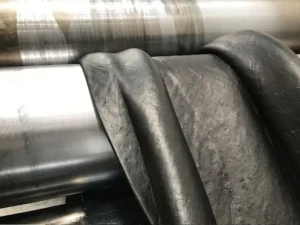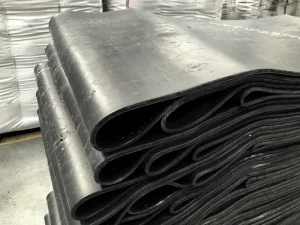La gomma ha un'ampia capacità di utilizzo. Dai pneumatici per auto ai parabordi marini, questo materiale serve perfettamente allo scopo. Tuttavia, la gomma ha una durata specifica e dopo inizia a indebolirsi. Questo indebolimento del materiale in gomma fa sì che ci si chieda: La gomma marcisce?
No, la gomma non marcisce. Al contrario, si degrada. La putrefazione è comune nei materiali organici come il legno. Il degrado è standard nel materiale di gomma. Quindi, il materiale inizia a perdere la sua qualità. Molti fattori contribuiscono alla sua degradazione, come il calore, i raggi UV, l'ossidazione, ecc.
Marciume e degrado sono due concetti diversi. La gomma, sia naturale che sintetica, subisce un deterioramento nel tempo. La comprensione di questo argomento è essenziale per l'acquisto di prodotti in gomma come i parabordi marini. Quindi, continuate a leggere mentre mi immergo!
Di cosa è fatta la gomma?

Prima di affrontare la nostra domanda principale, cerchiamo di capire la formazione della gomma. Esistono due tipi di gomma, che si differenziano per la produzione. Si tratta della gomma naturale e di quella sintetica. La gomma naturale si ottiene da un liquido di colore bianco chiamato lattice. Ma la domanda sorge spontanea: Da dove proviene questo lattice?
Il lattice viene estratto da un albero chiamato Hevea Brasiliensis. Non viene utilizzato direttamente dagli alberi. Viene invece sottoposto a una serie di processi per formare un sottile pezzo di gomma. La gomma naturale ha un livello di elasticità superiore. La gomma ricavata dal lattice è diversa dalla gomma sintetica.
La gomma sintetica viene prodotta artificialmente attraverso il processo di polimerizzazione. In questo processo vengono utilizzati alcuni prodotti petrolchimici. I produttori possono aggiungere additivi durante il processo di produzione. Di conseguenza, possono ottenere vantaggi personalizzati in base alle loro esigenze di produzione. I produttori utilizzano ampiamente sia la gomma naturale che quella sintetica.
La gomma si deteriora?

Sì, la gomma si deteriora o si degrada nel tempo. Tuttavia, il suo deterioramento non è come quello di altri composti organici. Per degrado si intende l'usura e la lacerazione della gomma nel corso del tempo. Alcuni fattori specifici rompono le particelle della gomma. A causa di ciò, perde la sua elasticità e si rompe.
Innanzitutto, sfatiamo il mito popolare che la gomma marcisca. Non è vero! Nessun prodotto in gomma marcisce, ma si deteriora nel tempo. La putrefazione è il processo di decadimento che avviene nella materia organica. Ad esempio, il legno, le piante e i rifiuti alimentari possono decadere a causa della loro decomposizione chimica.
Tuttavia, il deterioramento è diverso dalla marcescenza. In questo deterioramento, i cambiamenti chimici avvengono lentamente nel materiale. La marcescenza e il deterioramento influiscono sulla qualità del materiale. Tuttavia, la gomma si deteriora e si degrada dopo un uso continuo per anni. È chiaro ora che la gomma non marcisce ma si deteriora?
Questa gomma marcia non può resistere alla pressione esterna e ai cambiamenti ambientali. Pertanto, non può svolgere correttamente le sue funzioni. I tipi di gomma non possono impedirne il deterioramento. Anche le gomme sintetiche con additivi aggiunti possono deteriorarsi. Tuttavia, il tempo di deterioramento può variare da tipo a tipo.
Se si nota che la lucidatura della gomma diventa sbiadita, è segno che ha iniziato a deteriorarsi. C'è poco da fare per fermare questo deterioramento. Ogni materiale ha la sua vita, e lo stesso vale per la gomma. È possibile rallentare il deterioramento tenendola al riparo dalla luce solare o verniciandola.
La gomma utilizzata per la produzione di parabordi marini è imputrescibile?

No, la gomma dei parabordi marini non marcisce, ma si deteriora. L'utilizzo di gomma di alta qualità può aumentare la durata del deterioramento. Inoltre, una corretta manutenzione può realizzare i suoi parafanghi in gomma durano più a lungo. Ma non c'è da preoccuparsi: il degrado non è istantaneo.
I parabordi marini sono generalmente realizzati in gomma sintetica. Questa gomma è solida, elastica e in grado di assorbire gli urti. A causa della sua robustezza, molti credono che sia invincibile al degrado, ma è sbagliato. Il periodo di degrado della gomma utilizzata nei parafanghi è molto elevato. Pertanto, i parafanghi rimangono in buona forma per anni.
La ragione principale del loro deterioramento è l'acqua salata. Inoltre, non possiamo ignorare l'impatto dell'esposizione costante alla luce solare e ai raggi UV. A causa di questo lento ma costante degrado, i parabordi marini perdono la loro elasticità. Una volta che la loro elasticità diminuisce, le loro prestazioni si riducono. Per questo motivo, i proprietari delle imbarcazioni li sostituiscono con altri nuovi.
Tuttavia, esistono alcuni modi per prolungare la durata dei parabordi in gomma. Innanzitutto, è possibile utilizzare coperture proattive per questi parabordi marini. In questo modo li si proteggerà dall'impatto diretto dei raggi UV. Inoltre, è necessario mantenerli asciutti e puliti quando sono in magazzino. I controlli regolari di questi parabordi sono essenziali.
Cause del marciume secco della gomma (deterioramento)
Il marciume secco nella gomma indica un deterioramento, non la decomposizione che si osserva nella materia organica. Molti fattori contribuiscono alla marcescenza secca della gomma. La comprensione di questi fattori vi aiuterà a prevenire la marcescenza secca nei vostri prodotti in gomma. Vediamo quindi di analizzarli uno per uno.
1- Invecchiamento della gomma
L'invecchiamento è un processo naturale e graduale per le gomme. Come sapete, ogni materiale ha una vita specifica. Giusto? Allo stesso modo, anche la gomma rimane in buono stato per un determinato periodo di tempo. In seguito, invecchia e si degrada a seconda dell'intensità dell'uso. Se avete dei parafanghi in gomma, inizieranno a degradarsi anche se li tenete con estrema cura.
Questo è uno degli svantaggi dell'utilizzo di materiali in gomma. Diversi fattori, come le alte temperature o i raggi UV, accelerano l'invecchiamento. L'aspetto positivo è che il materiale in gomma invecchia generalmente dopo molti anni, quindi è possibile mantenerlo in uso per molto tempo. Tuttavia, arriverà il momento in cui dovrete sostituire il prodotto.
2- Temperatura alta o bassa
La gomma è sensibile alla temperatura. Non può tollerare temperature troppo alte o troppo basse. Tuttavia, ogni tipo di gomma ha una diversa tolleranza alla temperatura. A temperature molto elevate, le particelle di gomma subiscono una rottura termica. Immaginiamo un prodotto in gomma utilizzato a una temperatura elevata di 70 gradi Celsius.
Questa temperatura elevata riduce la flessibilità e l'elasticità della gomma fino a 50%. A bassa temperatura, le molecole di gomma diventano rigide e fragili. Avete notato che la gomma in inverno si rompe facilmente? Ciò è dovuto alla bassa temperatura, che rende le molecole rigide e facili da rompere.
Anche i parafanghi in gomma sono generalmente soggetti a questo problema. In genere, la loro qualità inizia a diminuire con la fluttuazione di temperature estreme. Le alte temperature ne riducono l'elasticità. Al contrario, le basse temperature li rendono meno adatti ad assorbire gli urti e soggetti a crepe.
3- Esposizione alle radiazioni UV
Le radiazioni ultraviolette provengono principalmente dalla luce solare. Giusto? Quando la gomma è esposta a questi raggi per un periodo prolungato, le molecole di gomma iniziano a deformarsi. Questa deformazione o rottura delle molecole è dovuta alla fotossidazione. Si tratta di un tipo di ossidazione che avviene in presenza di luce.
Ricordate che l'impatto dei raggi UV non è immediato. Al contrario, si deteriora lentamente e influisce sulla qualità del materiale in gomma. Di conseguenza, il prodotto inizia a perdere forza e flessibilità. L'esposizione costante ai raggi UV provoca la formazione di crepe. Queste crepe si ripercuotono sulla gomma espandendosi.
Evidenziazione rapida: I diversi materiali in gomma possono rispondere in modo diverso alle radiazioni UV. Tuttavia, tutti ne risentono in qualche misura. Nessuna gomma è 100% al sicuro dall'impatto dei raggi UV. Per questo motivo si raccomanda di non esporre a lungo i prodotti in gomma alla luce solare estrema.
4- Impatto di umidità, pressione e ozono
Sia l'umidità che la pressione sono dannose per la longevità della gomma. Sapete perché i parafanghi in gomma diventano fragili rapidamente? È a causa del contatto costante con l'acqua e l'umidità. La gomma assorbe più rapidamente l'umidità, rendendo le molecole morbide e facili da marcire.
Il vento ad alta pressione riduce anche l'aspetto fisico della gomma. L'aspetto fisico costante della gomma è la gomma. Un altro grande problema che contribuisce a far marcire la gomma è l'esposizione all'ozono. Potreste sentirvi confusi su cosa sia l'ozono. Si tratta di tre molecole di ossigeno molto reattive. Quando la gomma è esposta a queste molecole, avviene una reazione.
La reazione influisce sulla struttura chimica della gomma, facendole perdere forza ed elasticità. Volete proteggere il vostro prodotto in gomma dall'impatto dell'ozono? Mantenete il vostro prodotto coperto. In questo modo eviterete l'esposizione a condizioni difficili, rendendolo sicuro.
5- Esposizione chimica e ossidazione
Le sostanze chimiche causano il deterioramento della gomma attraverso un processo chiamato degradazione chimica. Molti tipi di gomma sono sensibili a determinate sostanze chimiche. Quando la gomma entra in contatto con queste sostanze chimiche, le molecole iniziano a degradarsi. Questo degrado, se non controllato, può causare crepe più gravi.
L'ossidazione è un altro fattore che migliora la gomma secca. L'esposizione all'ossigeno influisce sulla qualità della gomma. L'ossigeno reagisce con la catena polimerica della gomma. Quando questa catena si rompe, si verifica il deterioramento e la fessurazione della gomma.
Prevenzione del deterioramento del materiale in gomma
Non è possibile arrestare completamente la marcescenza della gomma (degrado). Potrebbe sembrare una cosa negativa, ma è una sfortunata realtà. Tuttavia, è possibile adottare alcune misure per rallentare questo processo. Ecco alcuni consigli utili per tenere a bada il degrado della gomma.
- Prima di tutto, conservate sempre il vostro prodotto in gomma a una temperatura media. Esporre il prodotto a temperature troppo alte o troppo basse non è mai una buona idea.
- Quando i prodotti in gomma, come i parafanghi e altri, non vengono utilizzati, è bene tenerli coperti. Sono disponibili diverse coperture per parafanghi. Quando non vengono utilizzati, i parafanghi devono essere tenuti al sicuro in queste coperture.
- Anche l'ozono può influire sulla catena polimerica della gomma. Inoltre, non si può trascurare l'impatto dei raggi UV. Si consiglia di tenere il prodotto lontano da questi elementi.
- Sono disponibili diversi tipi di rivestimento protettivo. Questi rivestimenti proteggono le gomme dai raggi UV, dall'ozono, dall'umidità e da altre condizioni difficili. I parabordi marini possono trarre vantaggio dall'uso di questi rivestimenti. Perché? Perché questi rivestimenti resistono all'effetto dell'acqua salata.
- Non bisogna mai trascurare il proprio materiale o prodotto. Al contrario, è bene che sia sempre controllato e ben mantenuto. Ciò comporta un'adeguata pulizia e ispezione. Se si trovano sostanze chimiche sulla gomma, rimuoverle immediatamente.
Alcuni prodotti in gomma sono specializzati nel sopportare gli urti. Ne sono un esempio i parabordi utilizzati su navi e imbarcazioni. Quando non si attracca, i parabordi devono sempre essere conservati all'interno delle imbarcazioni o delle barche. In questo modo si evita che siano esposti all'umidità e alla luce del sole. Di conseguenza, avranno una vita migliore.
Domande frequenti
La gomma marcia può essere riciclata?
Sì, la gomma marcia o degradata può essere riciclata. Tuttavia, la qualità del prodotto riciclato finale dipenderà dal livello di degradazione.
Quanto dura la gomma?
La durata della gomma varia da tipo a tipo. Alcuni tipi, come l'isoprene o l'SBR, possono durare fino a 5 anni. La gomma più robusta, come il neoprene, può invece durare circa dieci anni.
La gomma si degrada con il tempo?
Sì, la gomma, sia essa naturale o sintetica, si degrada lentamente. Diversi fattori, come la luce solare, i raggi UV, l'ozono, la pressione e l'umidità, contribuiscono a questa degradazione.
Conclusione
La gomma è un materiale molto utilizzato grazie alla sua flessibilità ed elasticità. I produttori utilizzano la gomma per realizzare prodotti in grado di resistere agli urti. Ad esempio, i parabordi marini assorbono gli urti comprimendosi. Tuttavia, questo materiale non marcisce quando si tratta di marcire.
Tuttavia, il deterioramento è comune a quasi tutti i prodotti. Dalla gomma naturale a quella sintetica, tutti i tipi di gomma subiscono distorsioni. Non è possibile arrestare il deterioramento, ma è possibile rallentare il processo. Questa guida presenta tutte le misure di sicurezza per salvare i prodotti in gomma.
